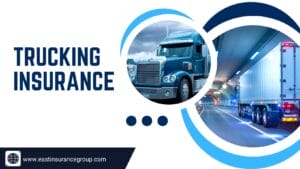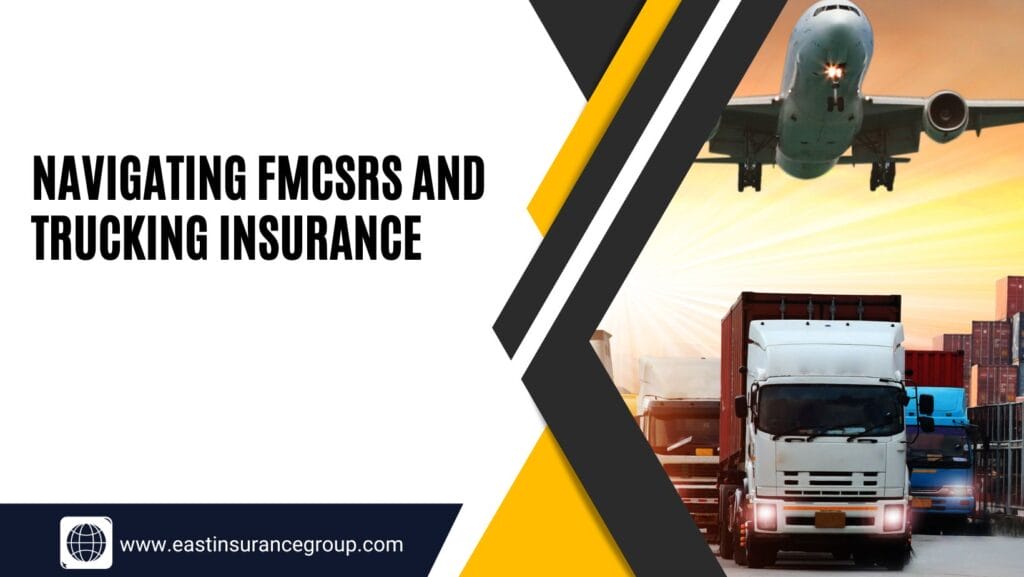I. Introduction
In the world of trucking, rules and regulations play a vital role in keeping everyone safe on the road. The Federal Motor Carrier Safety Regulations (FMCSRs) and Department of Transportation (DOT) regulations are like the traffic rules for truck drivers. They set the standards for how long drivers can be on the road, how trucks must be maintained, and much more.
It’s important for all trucking professionals to know about the rules and changes that are coming up. Every year, there are new rules to help make trucking safer and more efficient. To be successful and legal in the trucking industry, you need to understand these rules.
This article is your guide to understanding the important FMCSRs and DOT regulations.
We’ll talk about why they matter and why it’s crucial to stay up-to-date with the latest changes. We’ll also give you an overview of what’s coming in this article, including discussions about how FMCSRs and trucking insurance connect, the different types of trucking insurance, challenges with following the rules, and some helpful tips to stay on the right track.
So, let’s hit the road and explore the world of trucking rules and insurance in simple terms.
II. Understanding FMCSRs
FMCSRs might sound complex, but they’re basically the safety rules for trucking. They make sure that commercial motor carriers—companies that transport goods using big trucks—operate safely on the roads.
Imagine these rules as a giant book of guidelines, like a traffic rulebook, but specifically for trucks.
Here are the main categories and some of the regulations governed by FMCSRs:
- Hours of Service (HOS):
-
- Maximum driving hours per day and week.
- Required rest breaks and off-duty periods.
- Recording and documenting HOS in logbooks or electronic logging devices (ELDs).
- Driver Qualifications:
-
- Licensing requirements for commercial drivers.
- Medical qualifications for drivers.
- Background checks and driver history records.
- Vehicle Safety:
-
- Vehicle inspection and maintenance requirements.
- Standards for brakes, lights, tires, and other safety equipment.
- Weight limits and load securement.
- Cargo Securement:
-
- Regulations for securing cargo to prevent shifting or falling during transportation.
- Specific requirements for different types of cargo, such as hazardous materials.
- Transportation of Hazardous Materials (Hazmat):
-
- Safety regulations for transporting hazardous materials, including labeling, placarding, and emergency response requirements.
- Financial Responsibility:
-
- Insurance requirements to cover potential liabilities in case of accidents.
- Minimum insurance levels for motor carriers.
- Driver Training and Licensing:
- Requirements for driver training programs.
- Procedures for obtaining and renewing commercial driver’s licenses (CDLs).
- Alcohol and Drug Testing:
- Regulations for alcohol and drug testing of commercial drivers.
- Procedures for testing and consequences for violations.
- Compliance, Safety, and Accountability (CSA):
-
- A system that evaluates motor carriers and drivers based on safety performance and compliance with regulations.
- Scores and rankings that may trigger interventions or audits.
-
- Federal Licensing and Insurance Requirements for Motor Carriers (LLCs):
-
-
-
- Licensing and insurance requirements for motor carriers engaged in interstate commerce.
-
-
- Registration and Reporting:
- Requirements for registering commercial vehicles.
- Reporting procedures for accidents, incidents, and inspections.
- Electronic Logging Devices (ELDs):
-
-
- Mandates the use of ELDs for recording hours of service electronically.
-
These categories cover the core aspects of FMCSRs, which are designed to ensure safety, compliance, and accountability within the trucking industry. Each category includes specific regulations aimed at improving the safety and operations of commercial motor carriers and drivers. Trucking companies and drivers are expected to adhere to these regulations to maintain safety on the roads and meet legal requirements.
III. Staying Informed About FMCSRs for 2023
Keeping up to date with FMCSRs (Federal Motor Carrier Safety Regulations) and other DOT (Department of Transportation) regulations is like having a road map for a successful journey in the trucking industry. Here’s why it matters:
Why It Matters:
Understanding the latest rules is crucial for safe and legal trucking operations. Regulations change to adapt to new technologies, challenges, and safety concerns. Staying informed ensures that you’re on the right side of the law, maintaining safety and efficiency.
How to Stay Informed:
One of the best ways to stay updated is to visit the official FMCSA website. It’s like the official rulebook, and it’s where you’ll find the most current information about FMCSRs and DOT regulations. Additionally, consider subscribing to updates from the FMCSA. They’ll send you the latest regulatory information, making sure you’re always in the know.
Remember, in trucking, knowing the rules of the road can make all the difference in ensuring your safety, compliance, and peace of mind as you journey through the ever-changing landscape of the trucking industry.
IV. The Intersection of FMCSRs and Trucking Insurance
Navigating the world of trucking involves not just following the road rules but also meeting financial responsibilities. Here, we’ll look at how FMCSRs (Federal Motor Carrier Safety Regulations) and trucking insurance are interconnected and why it matters:
- The Connection: FMCSRs and trucking insurance are like two sides of the same coin. They are tightly linked because FMCSRs set the minimum insurance standards that trucking companies must meet. Think of it as a safety net; these standards ensure that carriers have the financial backing to cover any liabilities in case of accidents or incidents.
- Minimum Insurance Standards: The FMCSRs dictate how much insurance coverage trucking companies need to have. These minimum insurance levels provide protection for potential claims like property damage, bodily injury, and cargo loss. Meeting these standards is not just a regulatory requirement; it’s essential to safeguard your operations and financial well-being.
- Impact on Insurance Costs: The level of compliance with FMCSRs can directly influence the cost of trucking insurance. Safe and compliant companies often enjoy lower insurance premiums because they pose less risk. On the other hand, non-compliance or a history of accidents and violations can lead to higher insurance costs. So, following the rules is not just about safety; it’s about saving money too.
In essence, FMCSRs and trucking insurance are like partners on this journey. One sets the safety standards, and the other ensures you’re financially protected. It’s a crucial combination that every trucking operation needs to understand and manage effectively.
V. Types of Trucking Insurance

Just as there are different roads to travel, there are various types of insurance to choose from in the trucking world. Let’s take a look at the key types of insurance coverage available to trucking companies and how they connect with FMCSRs (Federal Motor Carrier Safety Regulations):
- Liability Insurance: This is like the primary shield for trucking companies. Liability insurance covers you in case of accidents where you’re at fault, protecting against claims for property damage or bodily injury. FMCSRs require a minimum level of liability coverage to ensure that carriers can take responsibility in case of accidents.
- Cargo Insurance: Just like you secure your seatbelt, cargo insurance secures your load. It covers any damage, loss, or theft of the goods you’re transporting. FMCSRs often include specific regulations for cargo securement, making cargo insurance an essential safeguard.
- Physical Damage Insurance: Think of this as “vehicle insurance.” It covers the repair or replacement of your truck in case of accidents, theft, or vandalism. While FMCSRs focus on the safety of your vehicle, having physical damage insurance ensures you’re financially protected.
These different types of insurance are like the gears in a well-oiled machine. They work together to ensure that you’re both safe and covered in the unpredictable world of trucking. FMCSRs play a key role in determining the minimum coverage levels for these insurances to guarantee that you’re adequately protected and compliant with regulations.
VI. Compliance Challenges and Risks
Following the rules of the road and meeting the standards set by FMCSRs (Federal Motor Carrier Safety Regulations) and insurance requirements can be a winding journey with its fair share of challenges and potential risks. Let’s shine a light on some of these obstacles and what’s at stake when it comes to compliance:
Challenges on the Road to Compliance:
- Tight Schedules: Meeting hours of service (HOS) regulations can be challenging when schedules are tight. Drivers need to balance delivering goods on time with the need for rest breaks.
- Vehicle Maintenance: Keeping trucks in top shape can be costly and time-consuming. Ensuring that vehicles meet safety regulations requires ongoing maintenance.
- Cargo Securement: Cargo can be tricky to secure properly, especially for different types of goods. Inadequate cargo securement can lead to compliance issues and accidents.
Legal and Financial Risks:
- Regulatory Violations: Non-compliance with FMCSRs can result in fines and penalties. Violations can tarnish a company’s safety record and reputation.
- Insurance Premiums: Poor safety records and non-compliance can lead to higher insurance premiums. This, in turn, affects a company’s financial health.
- Liabilities: In the event of accidents, companies may face legal liabilities. Without the right insurance coverage, they might be exposed to significant financial risks.
- Safety Incidents: Non-compliance can lead to accidents, injuries, or fatalities. These incidents have far-reaching consequences, both financially and ethically.
Navigating the trucking industry’s compliance landscape is like steering through a complex network of challenges and risks. It’s not just about rules and regulations; it’s about safety, reputation, and financial stability. Understanding the challenges and being aware of the potential risks is a crucial part of this journey.
VII. Resources for Staying Informed

Staying informed in the world of trucking regulations is like having a reliable GPS for your journey. Here are some essential resources and guidance to help you navigate the ever-changing landscape of FMCSRs (Federal Motor Carrier Safety Regulations) and DOT (Department of Transportation) regulations:
- FMCSA Website: The FMCSA website (www.fmcsa.dot.gov) is your primary source for the latest regulations, guidelines, and updates. It’s like the official rulebook for the industry.
- Subscribe to Updates:Consider subscribing to updates from the FMCSA. This ensures that you receive the most current regulatory information directly in your inbox.
- Legal Experts:Don’t hesitate to consult with legal experts who specialize in the trucking industry. They can provide you with in-depth guidance on complex regulations and compliance.
- Industry Associations: Engage with industry associations, such as the American Trucking Associations (ATA) or state-specific trucking associations. These organizations often track and communicate regulatory changes and can provide valuable insights.
- Online Forums and Communities: Participate in online forums and communities for truck drivers, carriers, and industry professionals. These platforms are great for sharing information, experiences, and staying updated on regulatory changes.
- Government Publications: Access government publications related to trucking regulations, such as the Federal Register, which publishes proposed and final rules.
- Webinars and Seminars: Attend webinars and seminars focused on trucking regulations and compliance. These events can provide in-depth knowledge and opportunities to ask questions.
- Trade Publications: Subscribe to trade publications and news websites that cover the trucking industry. They often report on regulatory changes and their impact.
Remember, staying informed is not just about knowing the rules; it’s about being prepared for the road ahead. These resources can be your best companions in understanding, complying with, and adapting to the latest FMCSRs and DOT regulations.
VIII. Conclusion
In the complex and ever-evolving world of trucking, there are essential takeaways to ensure a successful and legally compliant operation. Safety and compliance are not just goals but the very essence of your journey.
Key Takeaways:
- Safety is Non-Negotiable: Safety isn’t just a checkbox; it’s the bedrock of your operations. Prioritize safety at every turn.
- Compliance Is a Must: FMCSRs and DOT regulations are not mere guidelines; they’re the rules of the road. Compliance is your passport to legal and secure operations.
- Stay Informed: Regulations change, and the road ahead can shift. The key is to stay informed about the latest rules and regulatory updates. Make the FMCSA website your trusted companion.
- Adapt and Improve: Be proactive in identifying compliance challenges and risks. Regular training, communication, and consultation with legal experts are your tools for success.
- Foster a Culture of Safety: Safety isn’t just a practice; it’s a culture. Ensure that everyone in your organization understands its importance.
In closing, this journey is not just about reaching your destination; it’s about how you get there. Proactively monitoring and adapting to changing regulations isn’t just a necessity; it’s the route to a successful and legally compliant operation. Whether you’re a trucking company or a driver, remember that compliance and safety are your co-pilots on the road to success. Stay safe, stay compliant, and keep on trucking.

